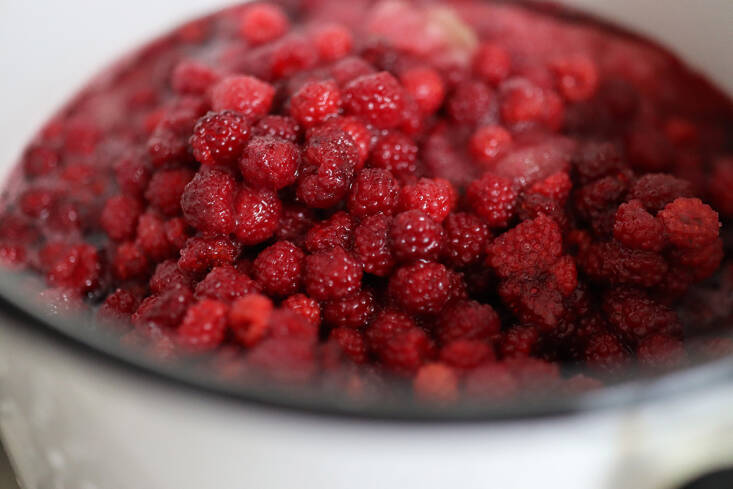Sticky summer brings edible delights to the forest edges. Chanterelles are in season, blueberries are ripening, and a shiny, scarlet raspberry relative is ready to collect: Wineberries are one of the prettiest of the aggregate fruits, their seeds hidden inside glossy drupelets so plump with juice that they appear about to burst. Collect as many as you like. This introduced and invasive shrub forms dense, prickly, shady thickets that prevent native plants from growing. But wineberries are a summer delicacy, and an hour’s dedicated picking yields pounds of useful fruit.
Photography by Marie Viljoen.

Like their raspberry and thimbleberry* cousins, wineberries belong to the Rubus genus. They are R. phoenicolasius, native to East Asia and imported to the United States in the late-19th century as hardy breeding stock for raspberries. Because the two regions’ climates are so similar (humid summers, cold winters), wineberries naturalized widely, and now displace native berries and other species.
(* Visit out Raspberry Cheat Sheet to tell the difference between these similar-looking fruit.)




In New York, wineberries ripen after native black raspberries, and just before blackberries, filling a brief, neat niche in the abundant summer months of soft fruit.

In my experience, these vivid berries are best eaten very simply, with minimal interference. Wineberries are soft, juice-filled, slightly tart, and delicately sweet. They tend not to be intensely flavored, but this could vary, depending on rainfall and whether they are growing in full sun or the high shade of woodlands. My favorite way to eat them is from a bowl, with a spoon. As a seasonal dessert it is elemental and ephemeral.


Mashed and muddled directly into drinks, wineberries are beautiful and their juiciness an asset. Cooked, their flavor intensifies.


I often put wineberries through a foodmill to separate the seeds, strain the juice once more, and use it fresh or cook it down into an unsweetened syrup; it stays good in the refrigerator for a week, and freezes well.

Adding sugar helps prolong their life, of course, so wineberry preserves (where the delicate fruit stays almost whole), jams, and jellies follow. They seem to contain very little pectin, and I find that boiling them too long is all too easy. For preserves, I heat the fruit gently to a simmering point, then allow them to cool completely before heating again.


I add lemon juice to my wineberry jams and watch the cooking pot closely—it reaches setting point quickly and briefly, and after that no amount of cooking will get it to gel. (Added pectin would also work.)

Drink the Weeds
A scarlet summer sipper.
- 10 wineberries
- 2 Tablespoons sugar
- 2 oz gin
- 3 springs pineapple mint
- Tonic
In a cocktail shaker or tall glass, crush the wineberries using a pestle or spoon. Drizzle a little of the juice out onto a saucer and dip the rim of your glass in it. Keeping the glass rim-side down, dip it gently into a saucer of the sugar. Stand it up to dry for a few minutes.
Add the gin and mint to the wineberry shaker or glass and muddle. Sit for a minute. Strain the mixture into your prepared glass (some seeds are fine), add ice, and top with tonic water.
See also:
- Summer on Ice: Easy Garden-Inspired Drinks for Your Next Get-Together
- Beach Plum: A Resilient Native Shrub for Flowers, Fruit, and Gin
- Taste of Summer: Surprising and Savory Ways to Enjoy Stone Fruit
Frequently asked questions
What are wineberries?
Wineberries are a type of small, red berry that belong to the raspberry family. They are native to Asia but have become invasive in many parts of North America.
How can I identify wineberries?
Wineberries have distinctive bright red fruit that looks similar to raspberries. They have a hollow core and are covered in fine red hairs. The leaves have toothed edges and are green on top and silvery underneath.
Are wineberries edible?
Yes, wineberries are edible and can be eaten raw or used in various dishes. They have a sweet and slightly tart flavor that is similar to raspberries.
Are wineberries invasive?
Yes, wineberries are considered invasive in many regions. They can spread quickly and crowd out native plants, leading to ecological imbalances.
How do wineberries spread?
Wineberries can spread through the seeds present in their fruits. Birds and animals often consume the berries and disperse the seeds through their droppings.
Can I control the spread of wineberries?
While it is difficult to completely eradicate wineberries once they are established, you can control their spread by regularly removing the plants and pruning back any new shoots. Be sure to dispose of the plants properly to prevent further spread.
Where can I find wineberries?
Wineberries are often found in woodland edges, roadsides, and disturbed areas. They thrive in full sun or partial shade and prefer well-drained soil.
When is the best time to harvest wineberries?
The best time to harvest wineberries is in mid to late summer when the berries are fully ripe. Look for berries that easily come off the plant with a gentle tug.
Are there any similar berries that may be mistaken for wineberries?
Yes, there are a few similar berries that may be confused with wineberries, such as raspberries and blackberries. However, wineberries have distinct red hairs and a hollow core, which can help differentiate them from other berries.
Are there any precautions I should take before eating wineberries?
It's always advisable to be cautious when foraging or consuming wild berries. Make sure you correctly identify the plant and ensure it is free from any contamination or pesticide use. If you have any known allergies or medical conditions, consult a healthcare professional before consuming wineberries or any other wild berries.








Have a Question or Comment About This Post?
Join the conversation